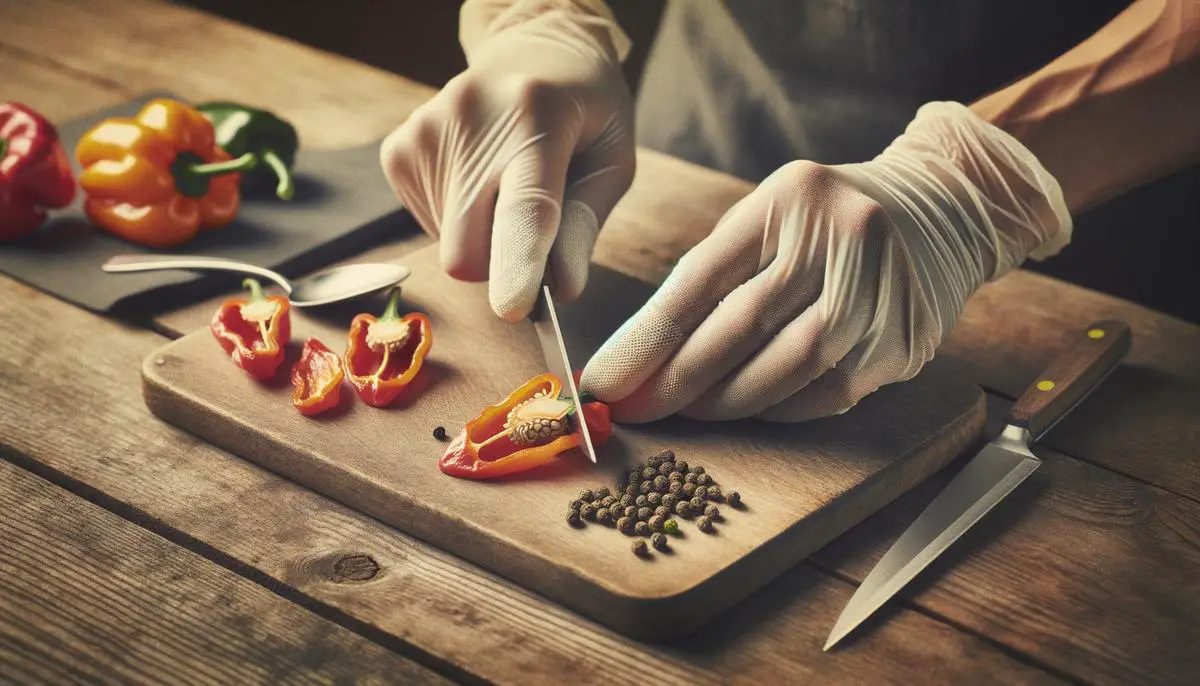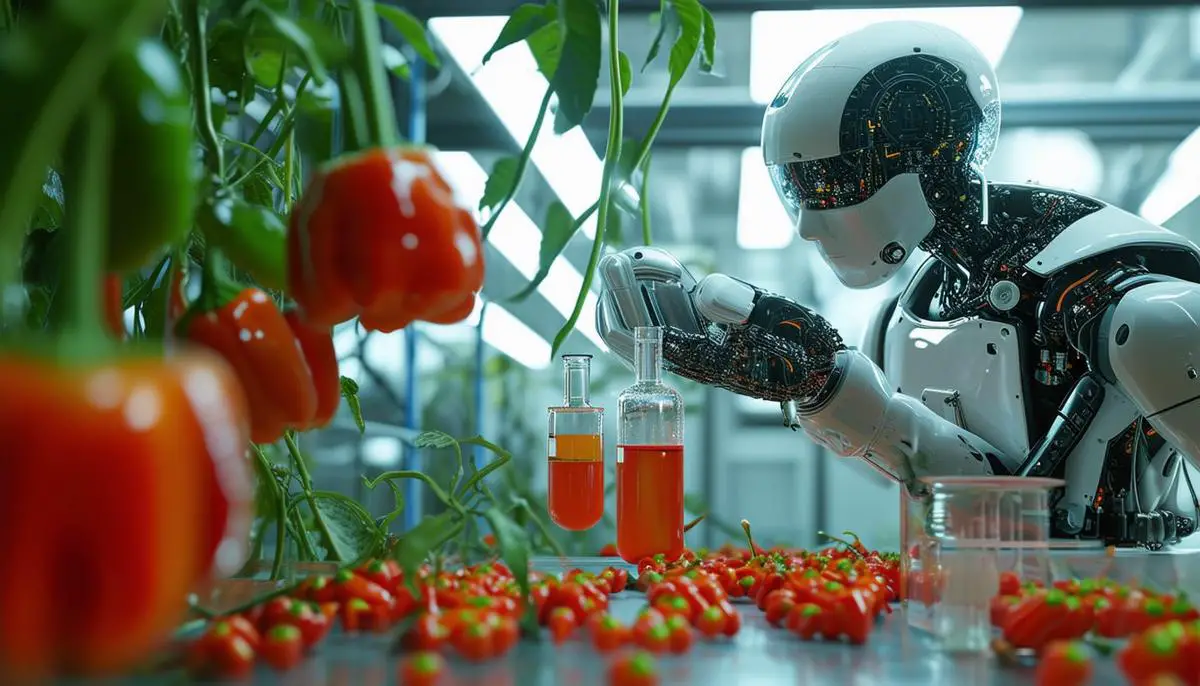
Habanero Heat and Flavor Profile
The Scoville Heat Units (SHU) scale measures the heat of habanero peppers. These peppers range from 60,000 to a fiery 600,000 SHU, which means they pack quite the punch! When comparing them to the common jalapeño, which tops out at about 8,000 SHU, it’s clear that habaneros are not for the faint-hearted.
But don’t let the heat scare you away. Habanero peppers have an intriguing flavor profile. They’re not just about bringing the pain; they offer a delightful blend of fruity and citrusy notes that can add depth to your dishes. Imagine a hint of papaya sweetness combined with the potent kick of spice—an explosive yet balanced flavor that can elevate your cooking.
As habanero peppers ripen, their heat levels change. Green habaneros are milder, but as they mature, turning from yellow to orange to red, they grow hotter. The ripening process intensifies both their heat and their fruity characteristics, resulting in more complex flavors. So, depending on your heat tolerance, you can choose your peppers accordingly.
When handling habaneros, cleaning out the seeds and the white membrane can help reduce the heat, as these parts hold most of the capsaicin, the compound responsible for the spiciness. Cooking them can also tone down the heat slightly while keeping the vibrant flavors intact, making them more approachable for those who prefer less intense heat.
In dishes like salsa or hot sauce, the combination of habanero’s heat and its fruity undertones can create a flavor launch that’s both fiery and refreshing. So, if you’re looking to add some heat with a twist to your cooking, habanero peppers are a fantastic choice. They bring not just the burn but also a burst of tropical flavor.
Handling and Cooking with Habaneros
Now, let’s talk about handling these fiery little devils. First and foremost, when dealing with habaneros, gloves are your best friends. The capsaicin in habanero peppers can cause a painful burn on your skin, and you don’t want that. And if you accidentally touch your face or, heaven forbid, your eyes, you’ll be looking for anything to soothe the burn.
Once you’ve got your gloves on, it’s time to prep these peppers. To manage their heat, remove the seeds and the white pith inside. These parts contain the highest concentration of capsaicin, so getting rid of them can make the pepper a bit more approachable. You’ll still get plenty of that delightful flavor, just not as much of the overwhelming heat.
Cooking with habanero peppers is where the magic happens. Their fruity, citrusy notes work wonders in a variety of dishes. If you’re new to habaneros, start sparingly. A little goes a long way. You might want to use just a small portion of one pepper to gauge the heat level you’re comfortable with.
One of my favorite ways to use habaneros is in homemade salsas. The combination of the pepper’s heat and its unique fruitiness adds a fantastic kick. Try this simple recipe:
- Dice a small piece of habanero
- Mix with tomatoes, onions, and cilantro
- Add a splash of lime juice and a pinch of salt
There you have it, a salsa that’s both refreshing and spicy.
Habanero powder is another great way to add heat to your dishes without the mess of chopping fresh peppers. It’s versatile and can be sprinkled sparingly over anything that needs a touch of spice. Add a pinch to your BBQ sauce for a smoky, spicy twist, or mix it into a chutney to give it an extra layer of flavor and heat. It’s also great for ramping up the spice in your chili or even sprinkling over a pizza for those who like it hot.
For those who love to experiment, try using habanero powder in unexpected places. A dash in your fruit jam can create an intriguingly spicy-sweet spread. Or, mix it into your chocolate cake batter for a dessert with a surprise kick. The key here is to balance the heat with other flavors to create a well-rounded dish that excites the taste buds.
Remember to handle your utensils carefully when working with habaneros. Clean your knives and cutting boards thoroughly to avoid any unintended spice transfer to your next meal. And wash your hands well, even if you’ve used gloves. Capsaicin can linger, and you don’t want to accidentally rub your eyes and regret it.
With these tips in mind, you’ll be well-equipped to handle the heat of habaneros and incorporate their unique flavors into your cooking. So go ahead, spice things up and enjoy the fiery, fruity kick of these potent peppers. They may bring the burn, but they also bring a whole lot of flavor and fun to the kitchen.

Artificial Intelligence and Habanero Genome
Here’s something really interesting—how Artificial Intelligence is meeting the habanero pepper at the genetic level. Researchers at West Virginia University are using AI to study habanero genes. The goal? To predict and control the size, color, and even the taste of these hot peppers.1 Any tech that can help us manipulate something as complex as a pepper’s genome is pretty amazing.
The team, led by Professor Donald Adjeroh, is developing AI models to predict how genetic modifications can affect habanero peppers. They’re using AI to make educated guesses about what traits a pepper will have if certain genes are altered. This could mean bigger peppers, more vivid colors, and even tweaks to that signature heat. For all the cooking enthusiasts out there, imagine creating a habanero that’s perfectly suited to your heat tolerance!
They’ve partnered with West Virginia State University (WVSU) to grow genetically modified habaneros and put these AI predictions to the test. This collaboration is not just about peppers, though. It’s about using AI for broader applications, including human health. Adjeroh believes that the same techniques used to understand pepper genes could one day help us tackle genetic diseases like cancer.1 Imagine using AI to pinpoint which genes to manipulate to prevent a disease—it’s pretty incredible.
The research explores “pattern association discovery.” That means they’re figuring out how different genetic codes translate into physical traits, like the level of spiciness in a pepper. They’re solving a complex puzzle: mapping the genome to physical characteristics and human perception. And since human taste is so subjective, they’re even using consumer panels to evaluate the taste and spiciness of these AI-modified peppers.
Speaking of spiciness, there’s more to it than just personal tolerance. The scientists are conducting analyses to measure spice levels based on the chemical makeup of the peppers. This dual approach—combining human panels with lab tests—ensures a comprehensive understanding of what makes a habanero tick.
They’re also considering the long-term implications. Beyond just creating the perfect pepper, this technology could revolutionize how we approach crop phenomics—predicting and enhancing the desirable traits in all kinds of crops. Think of it as a high-tech way to ensure we get the juiciest tomatoes, the crunchiest cucumbers, and, of course, the spiciest habaneros.
The crossover to human health is equally exciting. Just like they’re mapping out which pepper genes affect traits like size and heat, they’re looking to apply the same principles to the human genome. The goal? Unravel how genes interact to cause diseases and ultimately find ways to prevent or treat them. It’s a challenging task, but the potential payoff is huge.
So, while you’re sprinkling a bit of habanero powder over your pizza or stirring it into your BBQ sauce, know that there’s a scientific field dedicated to making those flavors just right. And who knows—AI might soon be the secret ingredient to not just your perfect pepper, but perhaps even to groundbreaking advances in human health.
Incorporating these scientific advancements into everyday cooking could be the future. Imagine a world where you know exactly how spicy your homemade salsa will turn out because it’s been perfectly engineered! The culinary and medical possibilities are exciting. So keep those gloves handy, because the future of spice is here, and it’s powered by AI!

Incorporating habanero peppers into your cooking brings both heat and an exciting burst of flavor. From homemade salsas to innovative uses in desserts, these peppers offer endless possibilities. So next time you reach for some spice, remember the vibrant flavors and potential that habaneros bring to the table.
- West Virginia University. AI to improve the spice and color of peppers. Newswise. October 2021.



